If you’ve found a 1925 penny in your pocket change, you might be wondering if it holds any value beyond its face value. The good news? You’re in the right place to find out!
We’re going to explore the value of the 1925 penny, covering different mint marks, grading factors, and even rare error coins that collectors seek. So, let’s dive in and uncover the true worth of this nearly century-old coin!
1925 Penny Value Chart
| Mint Mark | XF45 | MS60 | MS65 | MS66 |
|---|---|---|---|---|
| 1925 No Mint Mark | Brown: $10 | Brown: $22 Red-Brown: $25 Red: $26 | Brown: $150 Red-Brown: $160 Red: $250 | Brown: $225 Red-Brown: $325 Red: $475 |
| 1925-D Penny | Brown: $26 | Brown: $85 Red-Brown: $100 Red: $125 | Brown: $400 Red-Brown: $950 Red: $4,250 | Brown: $2,650 Red-Brown: $3,000 Red: $93,000 |
| 1925-S Penny | Brown: $25 | Brown: $135 Red-Brown: $150 Red: $300 | Brown: $1,050 Red-Brown: $3,500 Red: $50,000 | Brown: $3,850 |
If you’re lucky enough to have a high-grade red variant, especially from the Denver or San Francisco Mint, you could be sitting on a coin worth thousands—or even tens of thousands—of dollars. Keep in mind that condition, rarity, and market demand all play a role in determining the final sale price.
History of the 1925 Penny
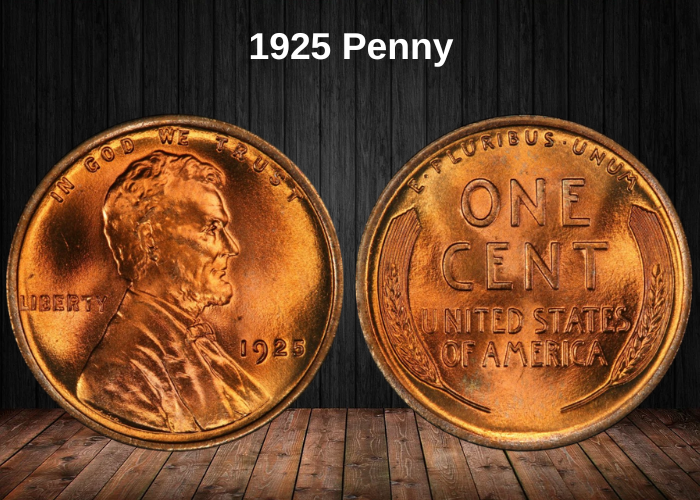
The 1925 penny is part of a series that holds a significant place in U.S. numismatic history. Known as the Lincoln penny, it was the first coin in the country to feature the portrait of a real person on its obverse.
The Origin of the Lincoln Penny
The first Lincoln penny was minted in 1909 to commemorate the 100th anniversary of Abraham Lincoln’s birth. Before this, U.S. coins typically featured Lady Liberty in their designs. Many believed that portraying a real person on currency was too reminiscent of monarchy.
However, as Lincoln’s centennial approached, public sentiment shifted, and President Theodore Roosevelt became a strong advocate for a Lincoln coin.
It is believed that Roosevelt personally suggested Victor David Brenner, a Lithuanian-born artist, as the designer. Brenner had previously created a portrait of Lincoln for a commemorative medal, and his coin design was based on a photograph taken by the renowned photographer Matthew Brady.
The Iconic Wheat Penny Design
The early Lincoln pennies, including the 1925 edition, are often called “Wheat pennies” or “Wheaties” due to the design on their reverse. This side of the coin features two stalks of wheat framing the inscription “ONE CENT”, a signature characteristic of the series.
In 1959, the reverse design was replaced with an image of the Lincoln Memorial in Washington, D.C., marking the 150th anniversary of Lincoln’s birth. Later, in 2009, four special reverse designs were introduced, depicting different stages of Lincoln’s life. Since then, modern pennies feature the Union Shield on the reverse.
Despite these changes, Lincoln’s portrait on the obverse has remained the same, making it the longest-running design in U.S. coin history.
Changes in the Composition of the Lincoln Penny
The 1925 penny was made of bronze, consisting of 95% copper and 5% tin and zinc. However, due to metal shortages during World War II, the 1943 Lincoln pennies were made of steel coated with zinc instead of copper.
As copper prices continued to rise, producing bronze pennies became increasingly expensive. To address this, in 1982, the U.S. Mint changed the composition again, switching to a zinc core with a thin copper coating. This maintained the familiar color while significantly reducing production costs.
If you compare a 1925 penny with a modern one, you’ll notice two key differences:
- Weight: The 1925 penny is heavier due to its higher copper content.
- Sound: When dropped on a wooden surface, the older penny produces a distinct metallic “ping”, while the modern one has a duller, more plastic-like sound.
Features of the 1925 Penny
The Obverse of the 1925 Penny
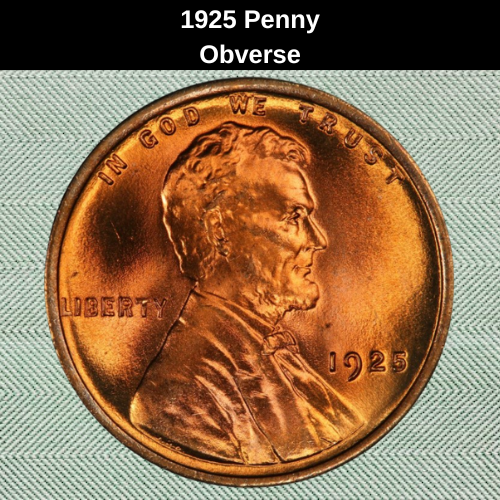
While a 1925 penny and its modern counterpart have several differences, they share one key feature: the obverse design remains unchanged.
Lincoln’s Portrait
For over a century, the Lincoln penny has featured a right-facing profile of Abraham Lincoln, capturing his head and shoulders in a dignified yet approachable manner.
Victor David Brenner, the artist behind this design, stated that he aimed to portray Lincoln as if he were reading to a child. This supports the belief that Brenner based his depiction on a photograph taken at Matthew Brady’s studio, which shows Lincoln alongside his young son.
If you look closely at the bottom of the portrait, you’ll notice Brenner’s initials (VDB). Originally, these initials appeared on the reverse of the 1909 Lincoln penny, but they were considered too prominent and were removed later that year. In 1918, they were reinstated on the obverse, where they remain to this day.
Other Design Features
- The well-known phrase “IN GOD WE TRUST” is displayed above Lincoln’s head.
- The word “LIBERTY” is inscribed to his left.
- The year of minting (1925 in this case) is positioned to the right of the portrait.
Mint Marks and Their Meaning
Not all 1925 pennies have a mint mark. It depends on where they were struck:
- No mint mark: Coins from the Philadelphia Mint (P) do not have any letter beneath the date.
- “D” mint mark: Coins from the Denver Mint feature a small “D” below the date.
- “S” mint mark: Coins from the San Francisco Mint have a small “S” in the same location.
These small details can have a huge impact on a penny’s rarity and value, making them crucial for collectors.
The Reverse of the 1925 Penny
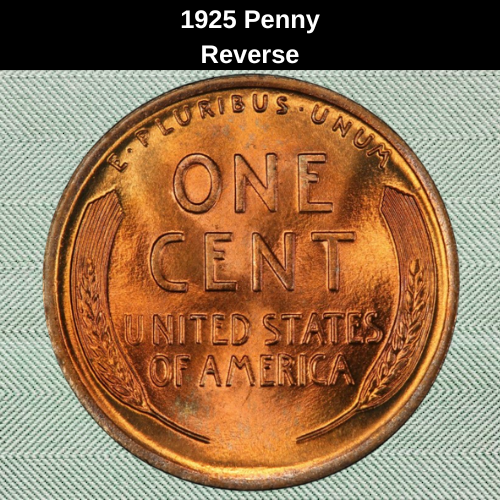
The reverse design of the 1925 penny was also crafted by Victor David Brenner, but it wasn’t his original concept.
Brenner’s Initial Design
Brenner initially proposed an image featuring a tree branch, but the Treasury rejected it. They felt it closely resembled contemporary French coins, leading him to create an alternative design.
The Wheat Penny Reverse
Brenner’s final design featured two stylized ears of durum wheat, framing the edges of the coin. This design became iconic, giving the Lincoln Wheat penny its well-known nickname.
- At the center, the denomination “ONE CENT” is prominently displayed in large lettering.
- Directly below it, the country name “UNITED STATES OF AMERICA” is written in a smaller font.
- At the top, following the curve of the coin’s edge, is the Latin phrase “E PLURIBUS UNUM”, meaning “From the many, one”. This represents the formation of the United States as a union of individual states.
Brenner’s wheat design remained on the penny for 50 years, until it was replaced by the Lincoln Memorial reverse in 1959.
Other Features of the 1925 Penny
The high copper content of the 1925 penny causes significant color variations between coins.
- Minimal exposure to air or handling preserves the bright red hue of fresh copper.
- Regular circulation and oxidation gradually turn the coin brown over time.
Color Grading & Value
The color of a 1925 penny plays a key role in its valuation. Professional grading services like PCGS and NGC categorize copper and bronze coins into three groups:
- Red (RD): At least 95% of the coin’s surface retains its original red color.
- Brown (BN): At least 95% of the coin has turned brown.
- Red and Brown (RB): A mix of both red and brown shades.
Coins with a full red color are generally the most valuable, as they have been better preserved over time.
If you’re interested in learning more about grading Lincoln pennies, check out Len Here’s YouTube video on the topic.
1925 Penny Grading
When determining the value of a 1925 penny, it is essential to understand grading standards. Coins are assigned a numerical grade based on their condition, ranging from heavily worn to flawless.
Coin Grading Breakdown:
| Grade Number | Grade Name | Description |
|---|---|---|
| 1 | Basal State-1 | Barely identifiable with heavy wear. |
| 2 | Fair | Major details worn away, but some elements visible. |
| 3 | Very Fair | Slightly clearer than Fair, but still very worn. |
| 4-6 | Good | Major features present but lacking sharpness. |
| 7-10 | Very Good | More details visible, but moderate wear remains. |
| 12-15 | Fine | Moderate wear with some key details still visible. |
| 20-30 | Very Fine | Light to moderate wear, with clear details. |
| 40 | Extremely Fine | Only slight wear on high points, sharp details. |
| 50 | About Uncirculated | Almost no wear, but minor imperfections. |
| 60 | Mint State | No wear, some small marks or blemishes. |
| 65 | Mint State | Highly attractive, minimal imperfections. |
| 70 | Mint State (Perfect) | A flawless coin with no visible marks. |
Why Coin Grading Matters?
The grade of your 1925 penny directly affects its market value. Higher-graded coins, especially those in Mint State (MS-60 or higher), tend to be more valuable.
To accurately determine your coin’s grade and value, refer to official grading guides or get it evaluated by a professional grading service like PCGS or NGC.
1925 Penny Value Guides
1925 No Mint Mark Penny Value
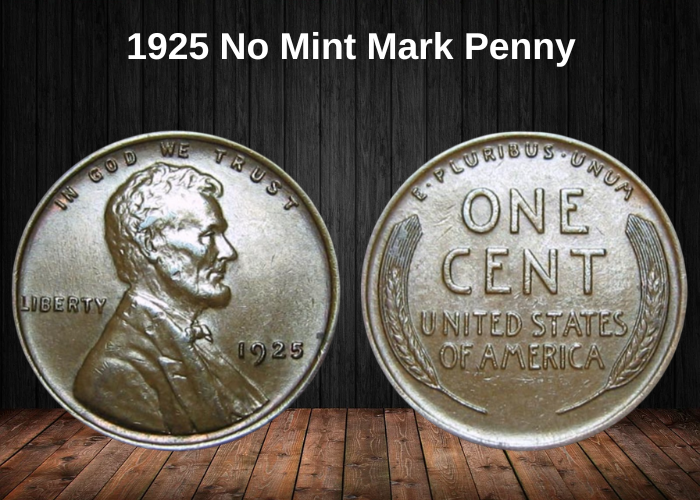
In modern times, Lincoln pennies are minted in billions, but back in 1925, the Philadelphia Mint produced a comparatively modest 140 million coins.
Survival & Rarity
According to PCGS, around 14 million of these coins still exist today. Finding a 1925 penny without a mint mark isn’t too difficult, but most of them are circulated brown coins, which are less valuable.
Coins that haven’t been used in circulation—referred to as being in “mint state” (MS)—tend to be worth more. Additionally, color matters:
- Brown (BN) coins are the most common.
- Red-Brown (RB) coins carry a higher value than brown ones.
- Red (RD) coins are the most desirable and command the highest prices.
1925 No Mint Mark Penny Value by Grade
The value of a 1925 penny depends on its condition (grade), rated on a 1 to 70 scale, with 1 being heavily worn and 70 being flawless.
| Grade | Brown (BN) Value | Red-Brown (RB) Value | Red (RD) Value |
|---|---|---|---|
| XF45 (Extremely Fine) | $10 | N/A | N/A |
| MS60 (Mint State) | $22 | $25 | $26 |
| MS65 (Gem Quality) | $150 | $160 | $250 |
| MS66 | N/A | $325 | $475 |
| MS67 | N/A | N/A | $1,500 |
| MS68 (Top Grade) | N/A | N/A | $65,000 |
The most valuable 1925 penny is a single red (RD) MS68 example, valued at an astonishing $65,000 by PCGS.
1925 D Penny Value
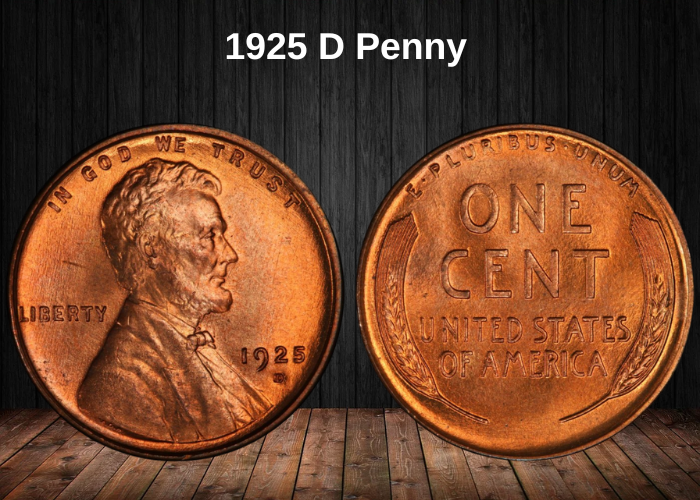
The 1925 Denver penny had a much lower mintage than its Philadelphia counterpart, with only 22,580,000 coins struck. However, just like the 1925 Philadelphia pennies, the majority of these are brown circulated coins. It is believed that only around 1,750 red pennies from the Denver mint remain, and just 160 of those are red gems.
This rarity is reflected in their value:
1925 D Penny Value by Grade
| Grade | Brown (BN) Value | Red and Brown (RB) Value | Red (RD) Value |
|---|---|---|---|
| XF45 (Extremely Fine) | $26 | N/A | N/A |
| MS60 (Mint State) | $85 | $100 | $125 |
| MS65 (Gem Quality) | N/A | $950 | $4,250 |
| MS66+ | N/A | $6,500 | N/A |
| MS66 (Top Grade) | N/A | N/A | $93,000 (3 known) |
| Highest Known (MS66) | $2,650 (brown) | N/A | $93,000 |
Key Takeaways:
- Brown 1925 D pennies start at $26 for XF45 and go up to $2,650 at MS66.
- Red and brown examples start at $100 and go up to $6,500 for the rare MS66+.
- Red 1925 D pennies are the most valuable, with MS65 examples worth $4,250 and MS66 examples reaching up to $93,000 (only 3 known).
These coins are incredibly rare, and especially in red condition, they are highly coveted by collectors!
1925 S Penny Value
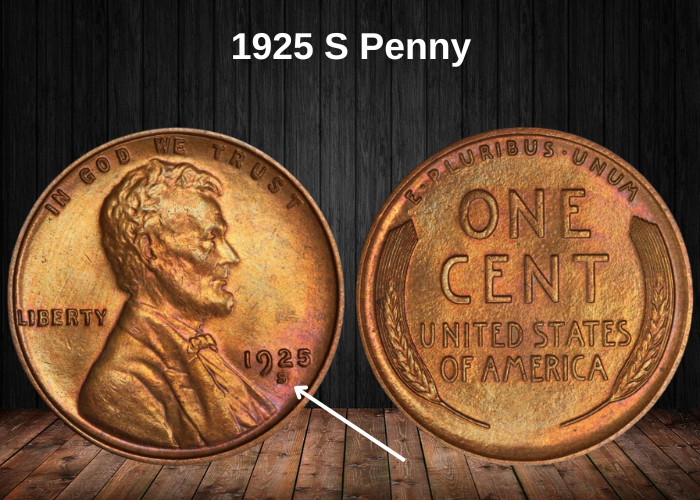
The 1925 S penny had a mintage of 26.3 million coins, struck at the San Francisco Mint, identifiable by the “S” mint mark below the date. While these pennies were not proof coins, they were intended for everyday circulation.
Rarity and Condition:
- One in ten of the 1925 S pennies are believed to survive at all grades, and around 1,200 are in mint state condition.
- The number of gem-quality (highest grade) coins is very rare, with only 45 believed to remain.
1925 S Penny Value by Grade
| Grade | Brown (BN) Value | Red and Brown (RB) Value | Red (RD) Value |
|---|---|---|---|
| Poor Condition | ~$1 | ~$1 | ~$1 |
| XF45 (Extremely Fine) | ~$25 | ~$25 | ~$25 |
| MS60 (Mint State) | ~$135 | ~$150 | ~$300 |
| MS65+ (Top Grade) | N/A | ~$10,000 | N/A |
| MS65 (Gem Quality) | N/A | ~$10,000 | ~$50,000 (14 known) |
Key Takeaways:
- Brown 1925 S pennies start at around $1 in poor condition, and at XF45, they’re worth about $25. Mint state coins start at $135.
- Red and brown 1925 S pennies can range from $150 at MS60 to $10,000 at MS65+.
- Red 1925 S pennies start at $300 at MS60, and the finest certified MS65 examples can be valued at $50,000. Only 14 coins have been certified at this level.
These 1925 S pennies are highly coveted by collectors, especially in red and gem conditions due to their rarity and historical significance.
Rare 1925 Penny Errors List
1925 S Penny, Double Die Obverse
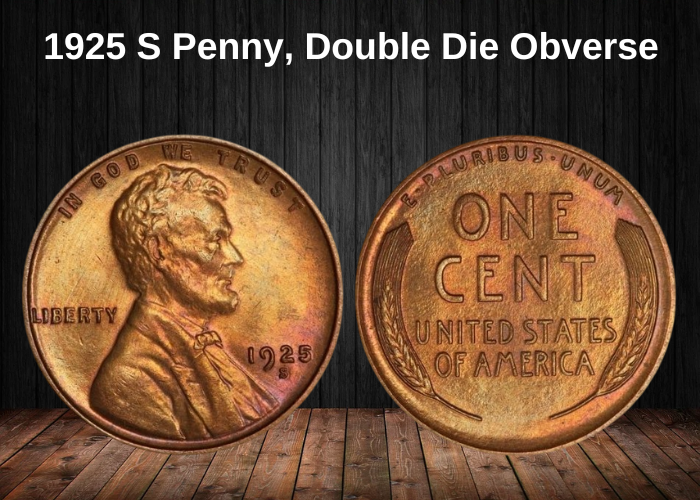
The 1925 S Double Die Obverse (DDO) penny is a rare and interesting mint error caused by a doubling of the design during the striking process. This happens when the die is struck more than once, causing misalignment in the image and creating extra lines or thickness on the coin’s design.
How to Identify a 1925 S DDO Penny:
- Look for extra thickness in the tail of the “9” in the date and a double line at the top of the “5”.
- You’ll need a microscope or loupe to spot the error clearly, as it’s not easily visible with the naked eye.
1925 S Double Die Obverse Value by Condition:
| Grade | Value (Brown) |
|---|---|
| Poor Condition | ~$20 |
| XF45 (Extremely Fine) | ~$110 |
| MS60 (Mint State) | ~$250 |
| MS65 (Gem Quality) | ~$1,450 |
Key Points:
- The 1925 S DDO penny is highly sought after by collectors due to its rarity and unique minting error.
- The value of these coins increases significantly depending on their condition.
- The highest certified example, in MS65 condition, can be worth as much as $1,450.
This error coin is an excellent addition to any collection, especially for those interested in minting flaws and historical U.S. coins.
1925 S Penny, Re-punched Mint Marks
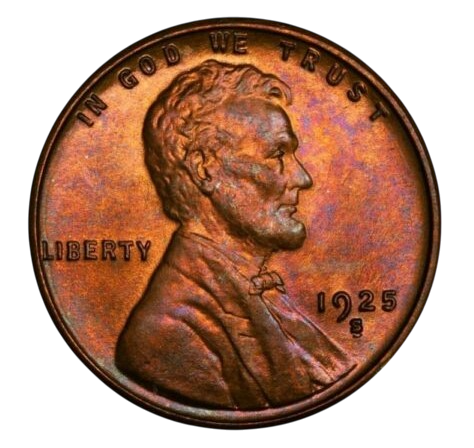
The 1925 S re-punched mint mark error is another rare and collectible flaw that can be found on some of the pennies struck at the San Francisco Mint that year. This error occurs when the mint mark (the “S” on the coin) is stamped more than once, resulting in a slightly offset or overlapping mint mark. You can spot this error by looking closely at the lower curve of the first “S” beneath the second.
Value of the 1925 S Re-punched Mint Mark Penny:
| Grade | Value (Brown) |
|---|---|
| Poor Condition | ~$27 |
| XF45 (Extremely Fine) | ~$120 |
| MS60 (Mint State) | ~$260 |
| MS65 Red (Gem Quality) | ~$43,000 |
Key Points:
- The 1925 S re-punched mint mark error is highly prized by collectors, especially in higher grades.
- The finest example ever certified, a red MS65 coin, is valued at a staggering $43,000.
- Like many mint errors, the value increases as the coin’s condition improves.
Collectors looking for rare 1925 S pennies will find this re-punched mint mark to be an exciting discovery, and it adds significant value to the coin. The red MS65 examples are especially sought after due to their scarcity and condition.
Where to sell your penny?
Now that you know the value of your penny, you might be wondering where to sell it. Don’t worry: here’s a guide to some of the best online platforms where you can easily sell your coins, along with their advantages and disadvantages.
Discover the best platforms for selling coins online (pros and cons).
FAQs
Q1: What is the 1925 Wheat Penny?
The 1925 Wheat Penny is a U.S. one-cent coin from the Wheat Penny series, which was in production from 1909 to 1958. Featuring Abraham Lincoln on the obverse and two ears of wheat on the reverse, this coin is a staple of American numismatics. The 1925 Wheat Penny was produced during the early 1920s, a period of prosperity following World War I and before the Great Depression.
Q2: What are the specifications of the 1925 Wheat Penny?
- Type: Wheat Penny
- Year: 1925
- Composition: 95% copper, 5% tin and zinc
- Total Weight: 3.11 grams
- Diameter: 19mm
- Minting Locations: Philadelphia, Denver, and San Francisco
Q3: How many 1925 Wheat Pennies were minted?
The mintages for the 1925 Wheat Penny were as follows:
- 1925 (Philadelphia): 121,750,000
- 1925 D (Denver): 14,520,000
- 1925 S (San Francisco): 3,050,000
While the Philadelphia mint produced the largest quantity, the 1925 S penny is considered rarer and more valuable due to its relatively low mintage, making it a sought-after coin for collectors.
Q4: What is the value of a 1925 Wheat Penny?
The value of the 1925 Wheat Penny can vary depending on its condition and mint mark. Below are approximate values based on the coin’s condition:
- 1925 (Philadelphia):
- Good: $0.40
- Very Fine: $1.50
- Extremely Fine: $3.00
- Uncirculated: $8.00 – $15.00
- 1925 D (Denver):
- Good: $0.75
- Very Fine: $3.00
- Extremely Fine: $7.00
- Uncirculated: $15.00 – $30.00
- 1925 S (San Francisco):
- Good: $2.00
- Very Fine: $5.00
- Extremely Fine: $10.00
- Uncirculated: $30.00 – $75.00
Q5: Why is the 1925 S Wheat Penny more valuable than the 1925 Philadelphia or 1925 D versions?
The 1925 S Wheat Penny is more valuable than the other varieties because of its low mintage of only 3,050,000 coins. Several factors contribute to its higher value:
- Rarity: The San Francisco mint produced far fewer pennies in 1925 than Philadelphia or Denver, making the 1925 S more scarce in both circulated and uncirculated conditions.
- Collector Demand: Due to its lower mintage and scarcity, the 1925 S has a strong demand among collectors, particularly those who focus on mint mark varieties or those building a complete Wheat Penny series.
- Regional Circulation: Because of its limited mintage, the 1925 S penny may have circulated primarily in the western U.S., making it harder to find in other regions.
Q6: What is the design of the 1925 Wheat Penny?
The 1925 Wheat Penny follows the classic Wheat Penny design introduced in 1909:
- Obverse: Features the portrait of Abraham Lincoln, designed by Victor David Brenner, with the year “1925” and the motto “IN GOD WE TRUST” inscribed on this side. The word “LIBERTY” appears to the left of Lincoln’s portrait.
- Reverse: Depicts two ears of wheat, with the inscription “UNITED STATES OF AMERICA” along the top, “E PLURIBUS UNUM” at the bottom, and “ONE CENT” in the center.
Q7: Are there any known errors or varieties with the 1925 Wheat Penny?
While the 1925 Wheat Penny is not particularly known for dramatic minting errors, there are some interesting aspects:
- Mint Mark Variations: The most notable variation in the 1925 series is the mint mark—whether the coin was minted at Philadelphia (no mint mark), Denver (D), or San Francisco (S). The 1925 S is particularly rare and highly sought after, making it the most valuable in the series.
- Die Variations: Like most years in the Wheat Penny series, there may be subtle die variations, such as different fonts or spacing in the lettering, but these do not usually result in high-value errors like those seen in other years.
Q8: How does the 1925 Wheat Penny compare to other years in the Wheat Penny series in terms of rarity and value?
The 1925 Wheat Penny is relatively common, particularly in its Philadelphia and Denver varieties. However, it still holds its place as a collectible coin in the Wheat Penny series due to the following:
- Commonality: The 1925 Philadelphia penny is not particularly rare, with a mintage of over 121 million coins, making it fairly accessible for collectors. However, in higher grades (e.g., MS-65 or above), it still has a decent value.
- Rare Mint Mark: The 1925 S penny is much rarer and more valuable than its Philadelphia counterpart due to its low mintage, which makes it more attractive to serious collectors.
- Collector Focus: The 1925 penny, like other coins in the Wheat series, is a key piece in building a complete collection of Lincoln Cents. For collectors aiming to complete a set, the 1925 S variety holds a particular appeal due to its rarity.



















































